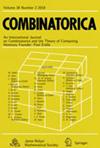求助PDF
{"title":"Set System Blowups","authors":"Ryan Alweiss","doi":"10.1007/s00493-025-00163-1","DOIUrl":null,"url":null,"abstract":"<p>We prove that given a constant <span><span style=\"\"></span><span data-mathml='<math xmlns=\"http://www.w3.org/1998/Math/MathML\"><mi>k</mi><mo>&#x2265;</mo><mn>2</mn></math>' role=\"presentation\" style=\"font-size: 100%; display: inline-block; position: relative;\" tabindex=\"0\"><svg aria-hidden=\"true\" focusable=\"false\" height=\"2.313ex\" role=\"img\" style=\"vertical-align: -0.505ex;\" viewbox=\"0 -778.3 2356.1 995.9\" width=\"5.472ex\" xmlns:xlink=\"http://www.w3.org/1999/xlink\"><g fill=\"currentColor\" stroke=\"currentColor\" stroke-width=\"0\" transform=\"matrix(1 0 0 -1 0 0)\"><use x=\"0\" xlink:href=\"#MJMATHI-6B\" y=\"0\"></use><use x=\"799\" xlink:href=\"#MJMAIN-2265\" y=\"0\"></use><use x=\"1855\" xlink:href=\"#MJMAIN-32\" y=\"0\"></use></g></svg><span role=\"presentation\"><math xmlns=\"http://www.w3.org/1998/Math/MathML\"><mi>k</mi><mo>≥</mo><mn>2</mn></math></span></span><script type=\"math/tex\">k \\ge 2</script></span> and a large set system <span><span style=\"\"></span><span data-mathml='<math xmlns=\"http://www.w3.org/1998/Math/MathML\"><mrow><mi mathvariant=\"script\">F</mi></mrow></math>' role=\"presentation\" style=\"font-size: 100%; display: inline-block; position: relative;\" tabindex=\"0\"><svg aria-hidden=\"true\" focusable=\"false\" height=\"1.912ex\" role=\"img\" style=\"vertical-align: -0.205ex;\" viewbox=\"0 -735.2 829.5 823.4\" width=\"1.927ex\" xmlns:xlink=\"http://www.w3.org/1999/xlink\"><g fill=\"currentColor\" stroke=\"currentColor\" stroke-width=\"0\" transform=\"matrix(1 0 0 -1 0 0)\"><use x=\"0\" xlink:href=\"#MJCAL-46\" y=\"0\"></use></g></svg><span role=\"presentation\"><math xmlns=\"http://www.w3.org/1998/Math/MathML\"><mrow><mi mathvariant=\"script\">F</mi></mrow></math></span></span><script type=\"math/tex\">\\mathcal {F}</script></span> of sets of size at most <i>w</i>, a typical <i>k</i>-tuple of sets <span><span style=\"\"></span><span data-mathml='<math xmlns=\"http://www.w3.org/1998/Math/MathML\"><mo stretchy=\"false\">(</mo><msub><mi>S</mi><mn>1</mn></msub><mo>,</mo><mo>&#x22EF;</mo><mo>,</mo><msub><mi>S</mi><mi>k</mi></msub><mo stretchy=\"false\">)</mo></math>' role=\"presentation\" style=\"font-size: 100%; display: inline-block; position: relative;\" tabindex=\"0\"><svg aria-hidden=\"true\" focusable=\"false\" height=\"2.614ex\" role=\"img\" style=\"vertical-align: -0.706ex;\" viewbox=\"0 -821.4 5158.2 1125.3\" width=\"11.98ex\" xmlns:xlink=\"http://www.w3.org/1999/xlink\"><g fill=\"currentColor\" stroke=\"currentColor\" stroke-width=\"0\" transform=\"matrix(1 0 0 -1 0 0)\"><use x=\"0\" xlink:href=\"#MJMAIN-28\" y=\"0\"></use><g transform=\"translate(389,0)\"><use x=\"0\" xlink:href=\"#MJMATHI-53\" y=\"0\"></use><use transform=\"scale(0.707)\" x=\"867\" xlink:href=\"#MJMAIN-31\" y=\"-213\"></use></g><use x=\"1456\" xlink:href=\"#MJMAIN-2C\" y=\"0\"></use><use x=\"1902\" xlink:href=\"#MJMAIN-22EF\" y=\"0\"></use><use x=\"3241\" xlink:href=\"#MJMAIN-2C\" y=\"0\"></use><g transform=\"translate(3686,0)\"><use x=\"0\" xlink:href=\"#MJMATHI-53\" y=\"0\"></use><use transform=\"scale(0.707)\" x=\"867\" xlink:href=\"#MJMATHI-6B\" y=\"-213\"></use></g><use x=\"4768\" xlink:href=\"#MJMAIN-29\" y=\"0\"></use></g></svg><span role=\"presentation\"><math xmlns=\"http://www.w3.org/1998/Math/MathML\"><mo stretchy=\"false\">(</mo><msub><mi>S</mi><mn>1</mn></msub><mo>,</mo><mo>⋯</mo><mo>,</mo><msub><mi>S</mi><mi>k</mi></msub><mo stretchy=\"false\">)</mo></math></span></span><script type=\"math/tex\">(S_1, \\cdots, S_k)</script></span> from <span><span style=\"\"></span><span data-mathml='<math xmlns=\"http://www.w3.org/1998/Math/MathML\"><mrow><mi mathvariant=\"script\">F</mi></mrow></math>' role=\"presentation\" style=\"font-size: 100%; display: inline-block; position: relative;\" tabindex=\"0\"><svg aria-hidden=\"true\" focusable=\"false\" height=\"1.912ex\" role=\"img\" style=\"vertical-align: -0.205ex;\" viewbox=\"0 -735.2 829.5 823.4\" width=\"1.927ex\" xmlns:xlink=\"http://www.w3.org/1999/xlink\"><g fill=\"currentColor\" stroke=\"currentColor\" stroke-width=\"0\" transform=\"matrix(1 0 0 -1 0 0)\"><use x=\"0\" xlink:href=\"#MJCAL-46\" y=\"0\"></use></g></svg><span role=\"presentation\"><math xmlns=\"http://www.w3.org/1998/Math/MathML\"><mrow><mi mathvariant=\"script\">F</mi></mrow></math></span></span><script type=\"math/tex\">\\mathcal {F}</script></span> can be “blown up” in the following sense: for each <span><span style=\"\"></span><span data-mathml='<math xmlns=\"http://www.w3.org/1998/Math/MathML\"><mn>1</mn><mo>&#x2264;</mo><mi>i</mi><mo>&#x2264;</mo><mi>k</mi></math>' role=\"presentation\" style=\"font-size: 100%; display: inline-block; position: relative;\" tabindex=\"0\"><svg aria-hidden=\"true\" focusable=\"false\" height=\"2.313ex\" role=\"img\" style=\"vertical-align: -0.505ex;\" viewbox=\"0 -778.3 4035.6 995.9\" width=\"9.373ex\" xmlns:xlink=\"http://www.w3.org/1999/xlink\"><g fill=\"currentColor\" stroke=\"currentColor\" stroke-width=\"0\" transform=\"matrix(1 0 0 -1 0 0)\"><use x=\"0\" xlink:href=\"#MJMAIN-31\" y=\"0\"></use><use x=\"778\" xlink:href=\"#MJMAIN-2264\" y=\"0\"></use><use x=\"1834\" xlink:href=\"#MJMATHI-69\" y=\"0\"></use><use x=\"2457\" xlink:href=\"#MJMAIN-2264\" y=\"0\"></use><use x=\"3514\" xlink:href=\"#MJMATHI-6B\" y=\"0\"></use></g></svg><span role=\"presentation\"><math xmlns=\"http://www.w3.org/1998/Math/MathML\"><mn>1</mn><mo>≤</mo><mi>i</mi><mo>≤</mo><mi>k</mi></math></span></span><script type=\"math/tex\">1 \\le i \\le k</script></span>, we can find a large subfamily <span><span style=\"\"></span><span data-mathml='<math xmlns=\"http://www.w3.org/1998/Math/MathML\"><msub><mrow><mi mathvariant=\"script\">F</mi></mrow><mi>i</mi></msub></math>' role=\"presentation\" style=\"font-size: 100%; display: inline-block; position: relative;\" tabindex=\"0\"><svg aria-hidden=\"true\" focusable=\"false\" height=\"2.209ex\" role=\"img\" style=\"vertical-align: -0.505ex;\" viewbox=\"0 -733.9 1063.8 951.2\" width=\"2.471ex\" xmlns:xlink=\"http://www.w3.org/1999/xlink\"><g fill=\"currentColor\" stroke=\"currentColor\" stroke-width=\"0\" transform=\"matrix(1 0 0 -1 0 0)\"><use x=\"0\" xlink:href=\"#MJCAL-46\" y=\"0\"></use><use transform=\"scale(0.707)\" x=\"1017\" xlink:href=\"#MJMATHI-69\" y=\"-213\"></use></g></svg><span role=\"presentation\"><math xmlns=\"http://www.w3.org/1998/Math/MathML\"><msub><mrow><mi mathvariant=\"script\">F</mi></mrow><mi>i</mi></msub></math></span></span><script type=\"math/tex\">\\mathcal {F}_i</script></span> containing <span><span style=\"\"></span><span data-mathml='<math xmlns=\"http://www.w3.org/1998/Math/MathML\"><msub><mi>S</mi><mi>i</mi></msub></math>' role=\"presentation\" style=\"font-size: 100%; display: inline-block; position: relative;\" tabindex=\"0\"><svg aria-hidden=\"true\" focusable=\"false\" height=\"2.309ex\" role=\"img\" style=\"vertical-align: -0.505ex;\" viewbox=\"0 -777 957.8 994.3\" width=\"2.225ex\" xmlns:xlink=\"http://www.w3.org/1999/xlink\"><g fill=\"currentColor\" stroke=\"currentColor\" stroke-width=\"0\" transform=\"matrix(1 0 0 -1 0 0)\"><use x=\"0\" xlink:href=\"#MJMATHI-53\" y=\"0\"></use><use transform=\"scale(0.707)\" x=\"867\" xlink:href=\"#MJMATHI-69\" y=\"-213\"></use></g></svg><span role=\"presentation\"><math xmlns=\"http://www.w3.org/1998/Math/MathML\"><msub><mi>S</mi><mi>i</mi></msub></math></span></span><script type=\"math/tex\">S_i</script></span> so that for <span><span style=\"\"></span><span data-mathml='<math xmlns=\"http://www.w3.org/1998/Math/MathML\"><mi>i</mi><mo>&#x2260;</mo><mi>j</mi></math>' role=\"presentation\" style=\"font-size: 100%; display: inline-block; position: relative;\" tabindex=\"0\"><svg aria-hidden=\"true\" focusable=\"false\" height=\"2.509ex\" role=\"img\" style=\"vertical-align: -0.705ex;\" viewbox=\"0 -777 2092.1 1080.4\" width=\"4.859ex\" xmlns:xlink=\"http://www.w3.org/1999/xlink\"><g fill=\"currentColor\" stroke=\"currentColor\" stroke-width=\"0\" transform=\"matrix(1 0 0 -1 0 0)\"><use x=\"0\" xlink:href=\"#MJMATHI-69\" y=\"0\"></use><use x=\"623\" xlink:href=\"#MJMAIN-2260\" y=\"0\"></use><use x=\"1679\" xlink:href=\"#MJMATHI-6A\" y=\"0\"></use></g></svg><span role=\"presentation\"><math xmlns=\"http://www.w3.org/1998/Math/MathML\"><mi>i</mi><mo>≠</mo><mi>j</mi></math></span></span><script type=\"math/tex\">i \\ne j</script></span>, if <span><span style=\"\"></span><span data-mathml='<math xmlns=\"http://www.w3.org/1998/Math/MathML\"><msub><mi>T</mi><mi>i</mi></msub><mo>&#x2208;</mo><msub><mrow><mi mathvariant=\"script\">F</mi></mrow><mi>i</mi></msub></math>' role=\"presentation\" style=\"font-size: 100%; display: inline-block; position: relative;\" tabindex=\"0\"><svg aria-hidden=\"true\" focusable=\"false\" height=\"2.209ex\" role=\"img\" style=\"vertical-align: -0.505ex;\" viewbox=\"0 -733.9 3215.7 951.2\" width=\"7.469ex\" xmlns:xlink=\"http://www.w3.org/1999/xlink\"><g fill=\"currentColor\" stroke=\"currentColor\" stroke-width=\"0\" transform=\"matrix(1 0 0 -1 0 0)\"><use x=\"0\" xlink:href=\"#MJMATHI-54\" y=\"0\"></use><use transform=\"scale(0.707)\" x=\"826\" xlink:href=\"#MJMATHI-69\" y=\"-213\"></use><use x=\"1206\" xlink:href=\"#MJMAIN-2208\" y=\"0\"></use><g transform=\"translate(2151,0)\"><use x=\"0\" xlink:href=\"#MJCAL-46\" y=\"0\"></use><use transform=\"scale(0.707)\" x=\"1017\" xlink:href=\"#MJMATHI-69\" y=\"-213\"></use></g></g></svg><span role=\"presentation\"><math xmlns=\"http://www.w3.org/1998/Math/MathML\"><msub><mi>T</mi><mi>i</mi></msub><mo>∈</mo><msub><mrow><mi mathvariant=\"script\">F</mi></mrow><mi>i</mi></msub></math></span></span><script type=\"math/tex\">T_i \\in \\mathcal {F}_i</script></span> and <span><span style=\"\"></span><span data-mathml='<math xmlns=\"http://www.w3.org/1998/Math/MathML\"><msub><mi>T</mi><mi>j</mi></msub><mo>&#x2208;</mo><msub><mrow><mi mathvariant=\"script\">F</mi></mrow><mi>j</mi></msub></math>' role=\"presentation\" style=\"font-size: 100%; display: inline-block; position: relative;\" tabindex=\"0\"><svg aria-hidden=\"true\" focusable=\"false\" height=\"2.509ex\" role=\"img\" style=\"vertical-align: -0.805ex;\" viewbox=\"0 -733.9 3310.4 1080.4\" width=\"7.689ex\" xmlns:xlink=\"http://www.w3.org/1999/xlink\"><g fill=\"currentColor\" stroke=\"currentColor\" stroke-width=\"0\" transform=\"matrix(1 0 0 -1 0 0)\"><use x=\"0\" xlink:href=\"#MJMATHI-54\" y=\"0\"></use><use transform=\"scale(0.707)\" x=\"826\" xlink:href=\"#MJMATHI-6A\" y=\"-213\"></use><use x=\"1253\" xlink:href=\"#MJMAIN-2208\" y=\"0\"></use><g transform=\"translate(2199,0)\"><use x=\"0\" xlink:href=\"#MJCAL-46\" y=\"0\"></use><use transform=\"scale(0.707)\" x=\"1017\" xlink:href=\"#MJMATHI-6A\" y=\"-213\"></use></g></g></svg><span role=\"presentation\"><math xmlns=\"http://www.w3.org/1998/Math/MathML\"><msub><mi>T</mi><mi>j</mi></msub><mo>∈</mo><msub><mrow><mi mathvariant=\"script\">F</mi></mrow><mi>j</mi></msub></math></span></span><script type=\"math/tex\">T_j \\in \\mathcal {F}_j</script></span>, then <span><span style=\"\"></span><span data-mathml='<math xmlns=\"http://www.w3.org/1998/Math/MathML\"><msub><mi>T</mi><mi>i</mi></msub><mo>&#x2229;</mo><msub><mi>T</mi><mi>j</mi></msub><mo>=</mo><msub><mi>S</mi><mi>i</mi></msub><mo>&#x2229;</mo><msub><mi>S</mi><mi>j</mi></msub></math>' role=\"presentation\" style=\"font-size: 100%; display: inline-block; position: relative;\" tabindex=\"0\"><svg aria-hidden=\"true\" focusable=\"false\" height=\"2.609ex\" role=\"img\" style=\"vertical-align: -0.805ex;\" viewbox=\"0 -777 7425.9 1123.4\" width=\"17.247ex\" xmlns:xlink=\"http://www.w3.org/1999/xlink\"><g fill=\"currentColor\" stroke=\"currentColor\" stroke-width=\"0\" transform=\"matrix(1 0 0 -1 0 0)\"><use x=\"0\" xlink:href=\"#MJMATHI-54\" y=\"0\"></use><use transform=\"scale(0.707)\" x=\"826\" xlink:href=\"#MJMATHI-69\" y=\"-213\"></use><use x=\"1151\" xlink:href=\"#MJMAIN-2229\" y=\"0\"></use><g transform=\"translate(2040,0)\"><use x=\"0\" xlink:href=\"#MJMATHI-54\" y=\"0\"></use><use transform=\"scale(0.707)\" x=\"826\" xlink:href=\"#MJMATHI-6A\" y=\"-213\"></use></g><use x=\"3294\" xlink:href=\"#MJMAIN-3D\" y=\"0\"></use><g transform=\"translate(4350,0)\"><use x=\"0\" xlink:href=\"#MJMATHI-53\" y=\"0\"></use><use transform=\"scale(0.707)\" x=\"867\" xlink:href=\"#MJMATHI-69\" y=\"-213\"></use></g><use x=\"5531\" xlink:href=\"#MJMAIN-2229\" y=\"0\"></use><g transform=\"translate(6420,0)\"><use x=\"0\" xlink:href=\"#MJMATHI-53\" y=\"0\"></use><use transform=\"scale(0.707)\" x=\"867\" xlink:href=\"#MJMATHI-6A\" y=\"-213\"></use></g></g></svg><span role=\"presentation\"><math xmlns=\"http://www.w3.org/1998/Math/MathML\"><msub><mi>T</mi><mi>i</mi></msub><mo>∩</mo><msub><mi>T</mi><mi>j</mi></msub><mo>=</mo><msub><mi>S</mi><mi>i</mi></msub><mo>∩</mo><msub><mi>S</mi><mi>j</mi></msub></math></span></span><script type=\"math/tex\">T_i \\cap T_j=S_i \\cap S_j</script></span>. We also show that the answer to the multicolor version of the sunflower conjecture is the same as the answer for the original, up to an exponential factor.</p>","PeriodicalId":50666,"journal":{"name":"Combinatorica","volume":"53 1","pages":""},"PeriodicalIF":1.0000,"publicationDate":"2025-07-23","publicationTypes":"Journal Article","fieldsOfStudy":null,"isOpenAccess":false,"openAccessPdf":"","citationCount":"0","resultStr":null,"platform":"Semanticscholar","paperid":null,"PeriodicalName":"Combinatorica","FirstCategoryId":"100","ListUrlMain":"https://doi.org/10.1007/s00493-025-00163-1","RegionNum":2,"RegionCategory":"数学","ArticlePicture":[],"TitleCN":null,"AbstractTextCN":null,"PMCID":null,"EPubDate":"","PubModel":"","JCR":"Q1","JCRName":"MATHEMATICS","Score":null,"Total":0}
引用次数: 0
引用
批量引用
Abstract
We prove that given a constant k ≥ 2 F w , a typical k -tuple of sets ( S 1 , ⋯ , S k ) F 1 ≤ i ≤ k F i S i i ≠ j T i ∈ F i T j ∈ F j T i ∩ T j = S i ∩ S j
设置系统爆炸
我们证明,给定一个常数k≥2k \ge 2和一个大集合系统F \mathcal F{,其集合的大小不超过w,则F }\mathcal F中的一个典型的集合k元组(S1,⋯,Sk)(S_1, \cdots, S_k)可以在以下意义上被“放大”:对于每一个1≤i≤k1 {}\le i \le k,我们可以找到一个包含SiS_i的大子族Fi \mathcal F_i{,使得对于i≠ji }\ne j,如果Ti∈FiT_i \in\mathcal F_i{和Tj∈FjT_j }\in\mathcal F_j{,则Ti∩Tj=Si∩SjT_i }\cap T_j=S_i \cap S_j。我们还证明了向日葵猜想的多色版本的答案与原始版本的答案相同,直到一个指数因子。
本文章由计算机程序翻译,如有差异,请以英文原文为准。

 求助内容:
求助内容: 应助结果提醒方式:
应助结果提醒方式:


